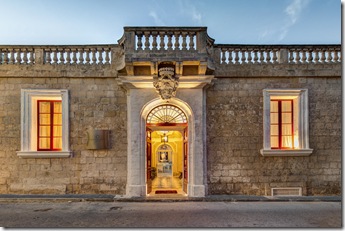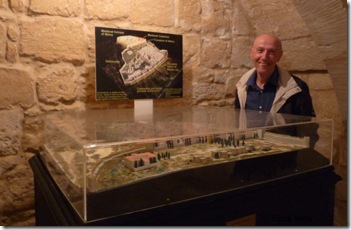-
Noble Stones
Edward Pullicino still remembers moments when as a young boy, whilst walking along one of the most prominent streets of Rabat, his late father Mario used to point out to him that Palazzo Castelletti belonged to their family. However, during that period, this historical building had been requisitioned by the government, and therefore the family could not enjoy its possession. Many of those who used this property made their own alterations to this old palace, at times even damaging it in the process, and Edward longed for the opportunity to reclaim it in order to restore it back to its glory. This aspiration became reality during these last years and today, a major part of this ancient gem has regained its splendour. Yet once again, Palazzo Castelletti was not destined to become a family residence. Instead, it has opened its doors to the public in order to serve as a stylish venue wherein one could relish this palace’s long and great legacy in Maltese history.
This palace was built in the 17th century as a private residence for the Theuma Castelletti family. Its distinct and prominent façade displaying the family’s intricate coat of arms, reflected the importance of its owners who formed part of the Maltese nobility. By the early 19th century, this building was extended further and this included the servants’ quarters. Apparently, some years later, this property was acquired by Baron Benedict Pisani Mompalao Cuzker, and the new residents of this palace were none other than the Blessed Maria Adeodata Pisani and her mother. The last landlord to live on the premises was Mgr. Prof. Carmelo Grima, an ancestor of the Pullicino family. He died in 1940 and from then on, the function of this building, alternated frequently as it passed from one hand to another.
In fact in 1941, this property was rented to the Nuns of St Joseph School, when they had to leave their premises in Paola, since it was taken over by the British Forces to be used as a hospital. When World War II broke out, these nuns decided to dig a shelter beneath the basement, with a separate exit on St Paul’s Street. Within it, the nuns and the students, together with some neighbours, used to take refuge during air raids. Once the war was over, these nuns returned to Paola, and between 1948 and 1958, Palazzo Casteletti was rented to L’Isle Adam Band Club and this place was turned into a social club. When this band club decided to move on the opposite side of the street, in Palazzo Xara, the Government of Malta requisitioned the building from its owners and divided it in two properties, namely 62 St Paul’s Street and 1 Old Doni Street. Part of the property was turned into government offices of the Social Services Department, whilst the other section was rented for private residence. In 1974, the Social Services Department left this building and the government seemed to be considering returning it to its owners. Edward’s parents, who were a freshly wedded couple, had in mind to occupy this palace as their private residence but their plans had to change when the government decided to split that part of the building into another two residences which were used for social housing. It was only in 2002, that the Pullicino family succeeded to recuperate part of Palazzo Castelletti, whilst the remaining section was acquired at a later stage, after the families that lived there were given alternative accommodations.
One would have imagined that after so many years during which the Pullicino family was negated the use of this palace, they would have opted to keep the premises for themselves. Yet, both because of the building’s spacious proportions and also due to the present trend where these historical places are being turned into commercial areas, the decision to turn this palace into a number of catering establishments was taken almost naturally.
Restoring the palace back to its original grandeur was not an easy task. Numerous alterations had taken place during the period when this property was used by third parties, including the building of further rooms in the courtyard, the division of large rooms into smaller ones, and the dismantling of some structures, including that of an old altar which was constructed during the years when Mgr Carmelo Grima had lived there. Luckily the latter was restored after it was found in pieces, together with a huge volume of rubbish and broken furniture, down in the old cellars which had been turned into a dumping site, though their original function was to store and ferment wine for the Castelletti family. The laborious work to remove this accumulation of trash eventually filled fifty loaded skips! Meanwhile, the additional structures were removed, whilst the authentic parts were restored, including the 20th century fountain stone statue of St Andrew which was sculpted by Luigi Muscat for Mgr Carmelo Grima in order to replace a pagan figure of Bacchus.
Great care was invested in identifying the original character of this place in order to respect its authenticity. Indeed, most of the rooms were repainted according to the colours which were retraced under the several layers of previous coatings, whereas a fresco which was painted by artist Mikiel Fsadni in the 1950’s was restored by Fr Charles Vella, revealing once again its rustic views of Maltese countryside and significant buildings that were adorned with intricate floral motifs and elaborate designs.
Interestingly, this restoration served to recover more than the original status of the palace itself, since during some structural works, it was discovered that the building rested on the remains of an ancient Roman village. After two years of archaeological excavations, this particular site revealed a section of a road of the Roman period, large ashlar blocks, some cisterns and channels, and a number of pottery, coins and jewelry. Most of the latter have been recovered by the Superintendence of Cultural Heritage but a very small selection of remains is available for public viewing, like this archaeological site itself.
The history of this era is vastly explained in a detailed exhibition which has been set up in the magnificently restored cellars that display an impressive series of interconnecting vaults which lie below the stately rooms of the palace. This exhibition is the work of Richard Azzopardi, a history enthusiast, who has researched in great depth the Roman era in Malta. Information panels provide interesting information related to Mdina and Rabat during this period, whereas a number of models portray his theories of how these places might have looked during this time. Moreover, this work also reveals an interesting finding of this researcher who has accessed various cellars in Mdina and Rabat, which areas have indicated that the original road in these zones during the Roman period lied at twelve feet below the present road-level. Indeed, this theory is supported by the archaeological site of the palace itself which shows that the excavated Roman road was situated within this calculated depth. This exhibition will remain open for viewing until September 2014.
(This article was published in the Property and Construction Supplement of the Times of Malta of 23rd April 2014)
Category: Times of Malta | Tags:


